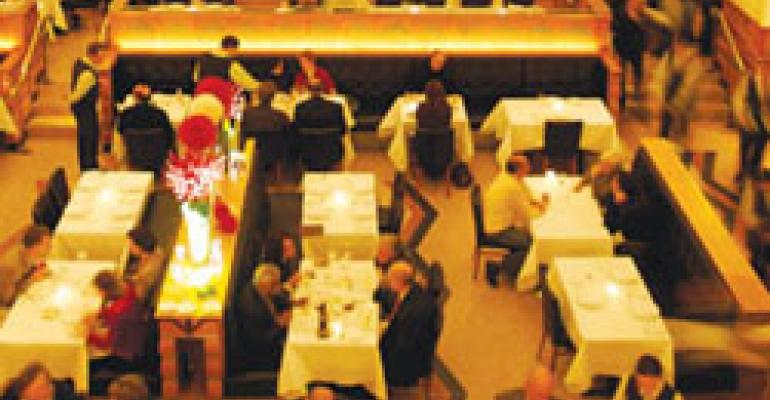High-end operators locked in a battle for dwindling dollar share are developing offbeat strategies to increase traffic and showcase more expensive menu items.
Restaurateurs are offering such innovative options as dine-arounds in which co-ops of neighboring Boston restaurants each serve a single course to shared four-course-dinner customers. Elsewhere, breaks from upscale-dining tradition are seen in mix-and-match prix-fixe menus, more à la carte items, less-pricey wine lists and shareable dessert plates.
“Yes, in a tough economy people eat out less,” said Paul Bolles-Beaven, core-business president of New York-based Union Square Hospitality Group, which operates such upscale concepts as Gramercy Tavern, Union Square Café, Tabla, the Modern and Eleven Madison Park.
In recent months the Union Square group has added 100 selections under $75 to the wine list of its namesake cafe; extended its restaurant-week menu through September at Tabla; sought to reward free-spending European tourists by pricing the wine list in euros at the Modern; and created a $38, two-course “Market Menu” for lunch at Eleven Madison Park.
At the latter restaurant, “fewer customers are doing business dinners,” Bolles-Beaven said. “Businesspeople who might have in the past wanted to impress their clients at dinner are now bringing them in for lunch. The Market Menu, which we created this spring, allows them to have an elegant meal and use lunch as an opportunity. And that has made our lunch business, which in July and August tends to be quite slow, very busy.
“People who care about quality and having a great dining experience don’t stop doing that when they economize. They’re still going to go to restaurants that provide that for them.”
Bolles-Beaven also indicated that USHG this summer has benefited from the weak U.S. dollar by seeing “a 10-percent-to-15-percent increase” in customers who are tourists from abroad.
An employee at The Modern, Graceanne Jordan, “came up with a wonderful idea to offer the wine list in euros,” Bolles-Beaven said. “This had two impacts. One, Europeans constantly having to do the math in their heads to convert currency felt taken care of and knew exactly what it was costing them. The other thing was they saw what a great value there was for them on the wine list [and] could see how much it cost to buy in New York as opposed to Europe.”
In Boston, Dave Petrillo, operator of the fine-dining Italian restaurant Prezza, joined forces with three neighboring competitors in an innovative moveable-feast collaboration to increase interest in all the establishments, which are located less than 400 yards from one another. Called the North End Progressive Dinner, the promotion allows customers to enjoy four courses—one at each restaurant—for $50, including gratuity. Wine is available at an additional $10 charge.
“We’ve teamed up with three other restaurants in the neighborhood and this gives us a chance to expose the public to all of the restaurants and give them an opportunity to try them,” he said. “They’re all small plates and can be appetizer, entrée or dessert dishes. We’ve done it three times so far and had great success. We probably get about 100 people; that’s where we cut it off. It helps promote someone else’s business, and that’s not a bad thing, but in order to do something like this you need restaurants that have good rapport.
“This definitely is a direct result of trying to stay ahead of the downturn,” Petrillo noted. “We’re just trying to be more proactive instead of reactive to it.”
In Boston, despite a decrease in the cost of lobster this summer, demand for the high-end crustacean was not as strong as originally anticipated. Diners were not going out of their way to order the shellfish.
But at Kingfish Hall, celebrity chef Todd English’s seafood restaurant in Boston, a campaign developed by director of operations Allison Williams changed all that. Called “31 Days of Lobster,” the promotion featured a lobster entrée prepared differently each night for $25.
“Originally it was supposed to run just for the month of July, but it proved so popular, we extended it through August,” she said. “The pricing [of lobster] this summer was really advantageous for restaurants and consumers, so I sat down and brainstormed with our executive chef. I asked if we could parlay the terrific prices into a promotion that our guests would perceive as having very high value. It was an opportunity for us to provide a high-end food item to our guests that was price-conscious and affordable, especially given the way the economy is.”
Michael Glick, owner of the three-month-old Parlor Steakhouse in New York City, said offering a varied price structure and a two-course, mix-and-match prix-fixe lunch option is attracting steady traffic.
“The prix-fixe lunch is $25 for three courses, and we allow the guests to chose how they want to build the meal, except they can’t double up on the entrée,” he said.
Menu prices, Glick said, range from $24 for hangar steak to $29 for a 7-ounce petite filet to $79 for a choice-cut Porterhouse for two.
“I can’t really read the economy,” he said. “One moment it’s up and the next it’s down, but I don’t think it can get much worse. People may decide not to go away on the weekend, but food is one of those commodities they’ll spend for. They won’t sacrifice on food.”




